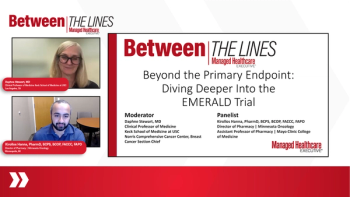
Key Baseline Characteristics of Patients in GALAXI-2 and GALAXI-3 Trials
Panelists discuss how the GALAXI trials enrolled a broadly generalizable population of adults with moderate to severe Crohn’s disease (CDAI 220-450) requiring objective evidence of active inflammation, including both bio-naive and bio-experienced patients with approximately 40% to 50% having previously failed advanced therapies, although patients previously exposed to ustekinumab or other p19 inhibitors were excluded due to the active comparator design.
Episodes in this series

Key Baseline Characteristics of GALAXI-2 and GALAXI-3 Patients
Inclusion Criteria and Patient Population
The GALAXI trials enrolled adults with moderate to severe Crohn’s disease, defined by Crohn’s Disease Activity Index scores ranging from 220 to 450, ensuring appropriate disease severity for study participation. Patients were required to have objective evidence of active inflammation based on endoscopic assessment, with Simple Endoscopic Score for Crohn’s Disease scores of at least 6, or 4 if inflammation was limited to the ileum. This endoscopic requirement added robustness to patient selection by confirming disease location and severity. The trials demonstrated broad inclusivity by allowing enrollment of biologic-naive patients and those previously exposed to anti-tumor necrosis factor (TNF) agents or other advanced therapies, with appropriate washout periods applied according to established guidelines for prior biologic exposure.
Exclusion Criteria and Study Limitations
Standard exclusion criteria included active infections, recent malignancy and other typical contraindications common to inflammatory bowel disease clinical trials. Crohn’s disease-specific exclusions encompassed patients with imminent surgical needs due to penetrating or stricturing disease complications, as well as those with existing stomas or short gut syndrome, reflecting the challenges of managing complex disease phenotypes within clinical trial frameworks. A notable limitation for clinical interpretation was the exclusion of patients previously exposed to ustekinumab or other IL-23p19 inhibitors, which was necessary due to the active comparator design but limits generalizability to ustekinumab-experienced patients in clinical practice. This exclusion prevented randomization of ustekinumab failures into the ustekinumab comparator arm, maintaining trial integrity but creating a knowledge gap for this patient subset.
Baseline Demographics and Clinical Practice Alignment
The baseline characteristics demonstrated excellent alignment with real-world clinical practice populations. Disease duration averaged eight to nine years, reflecting the typical patient population seen in specialized inflammatory bowel disease practices. Approximately 40% to 50% of enrolled patients had previously been exposed to or failed prior advanced therapies, representing a substantial proportion of treatment-experienced patients consistent with tertiary care demographics. The study achieved an approximately 50-50 distribution between biologic-naive and biologic-experienced patients, with over 90% of the exposed population having prior anti-TNF exposure and about 20% having vedolizumab experience. This broad patient representation, including those with long-standing disease and high inflammatory burden, enhances the generalizability of trial results to diverse clinical practice settings and supports the robustness of efficacy conclusions across different patient subgroups.
Newsletter
Get the latest industry news, event updates, and more from Managed healthcare Executive.




















































